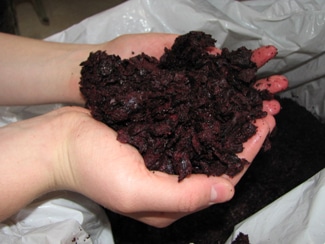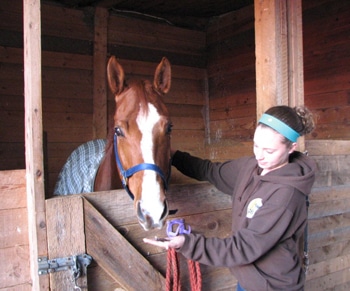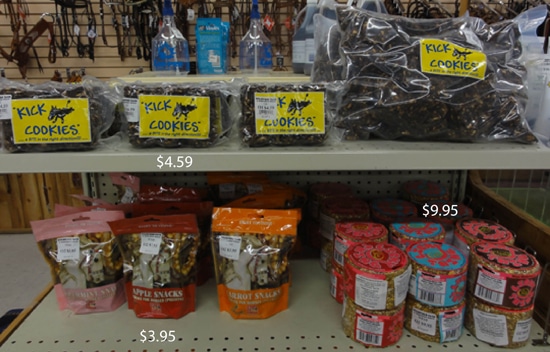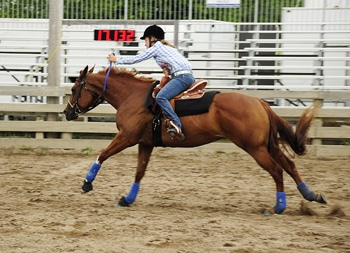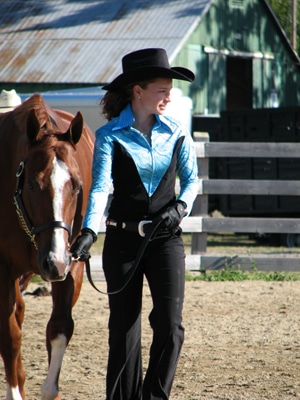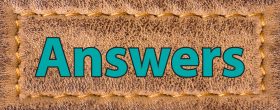We all love giving treats to our horses. Most of the time the ingredients include carrots and apples. Several years ago, Nicole van Dyk, a Nova Scotia high school student, came up with an innovative way of using blueberry pomace to make all-natural, nutritious horse treats, and received a silver medal at a national science fair in Toronto for her effort!
Nicole’s project was about using a waste product, blueberry pomace, a by-product of juicing the blueberry’s at her grandfather’s business, Vandyk’s blueberry juice.
Her inspiration for the project came from listening to her grandfather and father discussing the pomace.
“One day I was listening to him and my dad talk about blueberry pomace and the different uses for it,” she says. “It has about 50 per cent of the nutritional value left from the berry, and they were saying how one company puts it in dog treats. I thought if they could put it in dog treats, why couldn’t they put it in horse treats?”
To create her recipe, Nicole developed a survey with questions she hoped would provide answers that would help her with recipe design; size of treat, flavour, amount of treats fed by owners, shape of treat they preferred to feed etc.
She then placed her survey at feed stores, sent it to a few riding stables, posted it on Facebook for feedback, took copies to her 4H light horse club meeting and on some of her farm visits.
Her first question was, ‘Do you buy horse treats for your horse(s)?’ Thirty-three people responded ‘Yes’, nine responded ‘No’.
1. How many more people fed their horses treats than did not feed treats?
Next she asked, ‘How many bags of treats do you buy in a year/horse?’ She gave people four categories to chose from for their answer:
- Less than 2 bags (nine people chose this)
- 2 to 5 bags (sixteen people chose this)
- 5 to 10 bags (six people chose this)
- More than 10 (two people chose this)
2. What does Nichole mean by ‘year/horse’?
3. If one of the survey respondents choosing the second option (2 to 5 bags a year/horse) owned three horses and purchased 5 bags a year/horse, how many bags would they purchase altogether?
By now you may be wondering how much horse treats cost. Let’s do a little shopping.
4. If you bought three bags of the ‘Carrot Snacks’ displayed on the bottom shelf for $3.95 each, how much would they cost?
5. The Kick Cookies on the top shelf look good. You decide to buy 2 bags of those as well. How much would you spend?
6. You grab one of the round packaged treats as well because you want to do a little experiment of your own; a taste test to see if your horse likes one of the treats more than the others. You pay for all the treats with 1 twenty-dollar bill, 1 ten-dollar bill and 1 five-dollar bill. How much change do you get back?
At first Nichole tested 18 horses at a local farm with 3 treats made from different recipes. The 3 different recipes had 1 different ingredient (variable) in them and some constant ingredients; blueberry pomace, molasses, rolled oats and flax flour. One of the recipes was clearly more popular than the others. She baked up a big batch and headed to the nearest barn.
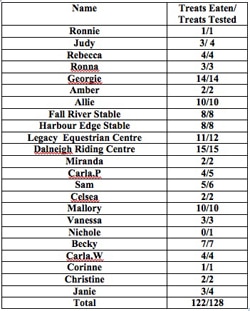
7. How many treats did Nichole test altogether during this phase of her project?
8. What percentage of the treats were eaten?
Satisfied with the results, Nichole sent the treat to be nutritionally tested.
“The results came back very positively. It had a lot of elements in it that horses require daily,” she says.
Nichole decided to make a business out of her horse treats, vanDyk Animal Treats. She needed to calculate how much it cost her to make the treats and how much to charge per bag.
“I also needed to begin to think about a labour cost to make the treats, cost of packaging and the cost of power I was using,” Nichole said. “This all needed to add in to the price per bag. I used metric conversions a lot too, between grams and kilograms, millilitres and litres and time units minutes to hour.”
One of Nichole’s main treat ingredients is Valley Flax flour. She knew from feeding her own horse, that when she added a little to her horse’s feed early every spring it always resulted in a beautiful coat when her horse shed out.
“The omega-3 fats seemed to give such a great shine to their coat and it is also high in protein and fibre and is great for their hoof health.” Nichole explains. “I wanted to create an all natural treat so Valley Flax flour seemed to go great with the health benefits of the blueberries. I bought the first bag of flax at a local store for $44.40 for 10kg but when I made it to Canada Wide Science Fair I contacted Harold Selig who owns Valley Flax to tell him I had used his flax and to get permission to use his company’s name. He met with my Dad and I and sold us our next bag at wholesale price and had lots of suggestions as well on a type of bag and label. The wholesale price would help make my overall treat bag price cheaper.”
9. Calculate the unit price (cost per kg) for flax when Nichole bought her first 10kg bag at the local store.
10. The wholesale price for a 10kg bag of flax was $23.25. How much was the unit price now?
Another of the main ingredients in Nichole’s horse treats is rolled oats. When she first started making the treats, she bought 1.35 kg bags at $3.79 per bag. Once she found a bulk supplier, she paid $33.95/25 kg.
11. Calculate the unit cost of rolled oats when Nichole first made her treats.
12. Calculate the unit cost of rolled oats when she buys from a bulk supplier.
Nichole had to weigh all her measured out ingredients for a single batch on a set of scales then use the unit costs (like those you calculated above) to determine the cost of ingredients for a single batch.
Then she weighed out the total treats made by one batch to help find the cost per 500 g bag.
At the fair, Nichole took a silver medal for her project. She won a $700 cash prize, as well as a $2,000 entrance scholarship to the University of Western Ontario if she chooses to go!
Horse Treats get Silver Medal at Science Fair – Answers:
1. How many more people fed their horses treats than did not feed treats?
Answer: 33 – 9 = 24. Twenty-four more people fed treats than did not feed treats.
2. What does Nichole mean by ‘year/horse’?
Answer: This is read as ‘year per horse’.
3. If one of the survey respondents choosing the second option (2 to 5 bags a year/horse) owned three horses and purchased 5 bags a year/horse, how many bags would they purchase altogether?
Answer: 3 x 5 = 15. They would purchase 15 bags altogether, 3 for each horse.
4. If you bought three bags of the ‘Carrot Snacks’ displayed on the bottom shelf for $3.95 each, how much would they cost?
Answer: 3 x 3.95 = 11.85. They would cost $11.85.
5. The Kick Cookies on the top shelf look good. You decide to buy 2 bags of those as well. How much would you spend?
Answer: 2 x 4.59 = 9.18. You would spend $9.18.
6. You grab one of the round packaged treats as well because you want to do a little experiment of your own; a taste test to see if your horse likes one of the treats more than the others. You pay for all the treats with 1 twenty-dollar bill, 1 ten-dollar bill and 1 five-dollar bill. How much change do you get back?
Answer:
Step 1: 11.85 + 9.18 + 9.95 = 30.98.
Step 2: $20 + $10 + $5 = $35.
Step 3: 35 – 30.98 = 4.02. You would received $4.02 back in change.
7. How many treats did Nichole test during this phase of her project?
Answer: 128
8. What percentage of the treats were eaten?
Answer: 122/128 x 100% = 95%. Ninety-five percent of the treats were eaten.
9. Calculate the unit price (cost per kg) for flax when Nichole bought her first 10kg bag at the local store.
Answer: $44.40 kg/10 kg = $4.40/kg
10. The wholesale price for a 10 kg bag of flax was $23.25. How much was the unit price now?
Answer: $23.25/10 kg = $2.33/kg
11. Calculate the unit cost of rolled oats when Nichole first made her treats.
Answer: $3.79/1.35 kg = $2.81/kg
12. Calculate the unit cost of rolled oats when she buys from a bulk supplier.
Answer: $33.95/25 kg = $1.36/kg
Common Core:
4.OA.A.3 – Multi-step word problems
5.NBT.B.7 – Multiply decimals and whole numbers: word problems; Add and subtract money: word problems;
6.NS.B.3 Fluently add, subtract, multiply, and divide multi-digit decimals using the standard algorithm for each operation.
6.RP.A.3c – Find a percent of a quantity as a rate per 100
6.RP.A.3d – Unit prices with customary unit conversions
Photos:
All photos courtesy of Nichole van Dyk



